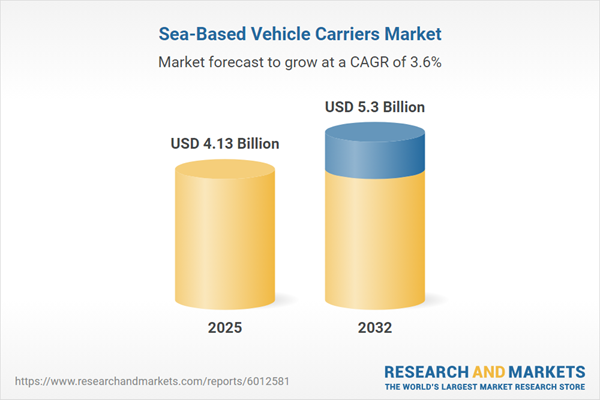Speak directly to the analyst to clarify any post sales queries you may have.
The global sea-based vehicle carriers market is evolving rapidly, shaped by advancements in vessel technology, digital transformation, and the drive for sustainable operations. For senior leaders navigating this landscape, understanding the latest developments and competitive dynamics is essential for future-proofing operations and seizing growth opportunities.
Market Snapshot: Sea-Based Vehicle Carriers Market Overview
The sea-based vehicle carriers market grew from USD 3.99 billion in 2024 to USD 4.13 billion in 2025 and is projected to reach USD 5.30 billion by 2032, advancing at a CAGR of 3.62%. Influenced by economic, regulatory, and technological forces, this market is marked by heightened focus on operational efficiency, reduced emissions, and compliance with diverse environmental standards. As global trade patterns fluctuate, industry participants must remain agile, leveraging innovation, sustainability, and real-time digital solutions to meet emerging demands and strategic priorities.
Scope & Segmentation: Comprehensive Market Coverage
- Vessel Types: Bulk Carriers (including Capesize, Handysize, Panamax, Supramax), Container Ships (Feeder, Feedermax, Panamax, Post Panamax, Ultra Large Container Vessels), General Cargo vessels (Heavy Lift, Multipurpose), Roll-On Roll-Off (Pure Car Carriers, Ro Pax, Vehicle Carriers), Specialized Carriers (Livestock Carriers, Offshore Support Vessels, Refrigerated Cargo Carriers), and Tankers (Chemical, Crude Oil, LPG, Product).
- Capacity Ranges: Less than 10,000 DWT, 10,000 to 50,000 DWT, 50,000 to 100,000 DWT, and Greater than 100,000 DWT.
- Service Types: Scheduled Services and Non-Scheduled Services.
- End-Use Industries: Automotive, Agriculture, Chemicals, Mining, Oil, and Gas.
- Propulsion & Fuel Types: Diesel, Gas Turbine, Hybrid Electric, LNG, Nuclear; Heavy Fuel Oil, LNG Fuel, Marine Diesel Oil.
- Operation Types: Bareboat Charter, Spot Charter, Time Charter, Voyage Charter.
- Ownership Structures: Integrated Shipowners, Government Entities, Leasing Companies.
- Regions Covered: Americas (United States, Canada, Mexico, Brazil, Argentina, Chile, Colombia, Peru), Europe, Middle East & Africa (United Kingdom, Germany, France, Russia, Italy, Spain, Netherlands, Sweden, Poland, Switzerland, UAE, Saudi Arabia, Qatar, Turkey, Israel, South Africa, Nigeria, Egypt, Kenya), and Asia-Pacific (China, India, Japan, Australia, South Korea, Indonesia, Thailand, Malaysia, Singapore, Taiwan).
- Leading Companies: A.P. Møller - Mærsk A/S, American Roll-On Roll-Off Carrier Group, Cargomax International Inc., CLdN Group, CMA CGM, Crowley Maritime Corporation, Eukor Car Carriers Inc., Evergreen Marine Corporation, Grimaldi Group, Höegh Autoliners, Hyundai Glovis Co., Ltd., International Vehicle Shipping Services, Kawasaki Kisen Kaisha, Ltd., Marvest GmbH, Mitsui O.S.K. Lines, MSC Mediterranean Shipping Company SA, NYK Line, and Pasha Hawaii.
Key Takeaways: Strategic Insights for Decision-Makers
- Ship operators are prioritizing digital navigation and visibility solutions to optimize routes, enhance cargo handling, and improve resilience across the vehicle carriers market.
- Sustainability directives are accelerating investments in hybrid and LNG propulsion systems, with carriers adopting greener fuels and energy management technologies to address emissions and stakeholder expectations.
- Operational models are diversifying; flexible charter structures and agile fleet deployment strategies are mitigating regional policy changes and supply chain uncertainties.
- Strategic partnerships with technology providers and port authorities are driving end-to-end logistics integration, offering improved traceability and efficiency.
- Segmented vessel types and targeted capacity investments are enabling operators to meet specific trade route requirements and support tailored services across industry verticals.
Tariff Impact: Navigating Policy and Trade Dynamics
Recently implemented United States tariffs have reshaped trade lanes, requiring vessel operators to reassess deployment strategies and cost structures. Carriers are increasingly utilizing alternative ports and multimodal logistics to circumvent affected routes. This shift has prompted manufacturers and importers to adopt longer-term planning, emphasize contractual agility, and explore risk-hedging options to maintain service reliability amid uncertain trade policy environments.
Methodology & Data Sources
This analysis employs a robust combination of primary and secondary research. In-depth interviews with executives, marine engineers, port operators, and charterers have illuminated real-world challenges and priorities. Publicly available regulatory filings, trade data, and industry publications supplement these insights. Rigorous frameworks, including SWOT and PESTLE, alongside scenario planning and advanced data visualization tools, establish a credible foundation for actionable findings.
Why This Report Matters: Actionable Value for Senior Leaders
- Enables C-suite executives to make informed, data-driven decisions by mapping current market forces and future outlooks across geographies.
- Equips operators and investors with strategic recommendations to enhance operational resilience, efficiency, and sustainability alignment.
- Delivers practical segmentation and competitive intelligence for setting priorities in fleet investments, digitalization, and market entry.
Conclusion
Adaptability is vital for success in the sea-based vehicle carriers market. This report provides strategic clarity and operational guidance, positioning your organization to respond confidently to industry transformation and emerging growth opportunities.
Additional Product Information:
- Purchase of this report includes 1 year online access with quarterly updates.
- This report can be updated on request. Please contact our Customer Experience team using the Ask a Question widget on our website.
Table of Contents
3. Executive Summary
4. Market Overview
7. Cumulative Impact of Artificial Intelligence 2025
Companies Mentioned
The companies profiled in this Sea-Based Vehicle Carriers market report include:- A.P. Møller – Mærsk A/S
- American Roll-On Roll-Off Carrier Group
- Cargomax International Inc.
- CLdN Group
- CMA CGM
- Crowley Maritime Corporation
- Eukor Car Carriers Inc.
- Evergreen Marine Corporation
- Grimaldi Group
- Höegh Autoliners
- Hyundai Glovis Co., Ltd.
- International Vehicle Shipping Services
- Kawasaki Kisen Kaisha, Ltd.
- Marvest GmbH
- Mitsui O.S.K. Lines
- MSC Mediterranean Shipping Company SA
- NYK Line
- Pasha Hawaii
Table Information
| Report Attribute | Details |
|---|---|
| No. of Pages | 188 |
| Published | November 2025 |
| Forecast Period | 2025 - 2032 |
| Estimated Market Value ( USD | $ 4.13 Billion |
| Forecasted Market Value ( USD | $ 5.3 Billion |
| Compound Annual Growth Rate | 3.6% |
| Regions Covered | Global |
| No. of Companies Mentioned | 19 |









